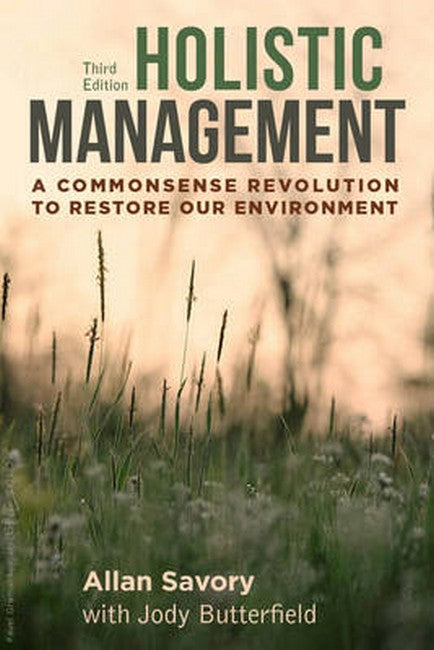Preface
Acknowledgments
Part 1: Introduction
1 Managing Holistically
Part 2: Four Key Insights
2 Introduction: The Power of Paradigms
3 Nature Functions in Wholes and Patterns
4 Viewing Environments a Whole New Way
5 The Predator-Prey Connection to Land Health
6 Timing is Everything
7 A New Management Framework
Part 3: The Holistic Context
8 Defining the Whole: What Are You Managing?
9 Creating the Context for Your Management
Part 4: The Ecosystem That Sustains Us All
10 Introduction: The Four Fundamental Processes That Drive Our Ecosystem
11 Water Cycle: The Circulation of Civilization's Life Blood
12 Mineral Cycle: The Circulation of Life-Sustaining Nutrients
13 Community Dynamics: The Ever-Changing Patterns in the Development of Living Communities
14 Energy Flow: The Flow of Fuel That Animates All Life
Part 5: The Tools We Use to Manage Our Ecosystem
15 Introduction: From Stone-Age Spears to Genetic Engineering
16 Money and Labor: One or Both of These Tools Is Always Required
17 Human Creativity: Key to Using All Tools Effectively
18 Technology: The First and Most Used Tool
19 Fire: An Ancient Tool Tied to Ancient Beliefs
20 Rest: The Most Misunderstood Tool
21 Living Organisms: Biological Tools for Solving Management Challenges
22 Animal Impact: A Tool for Regenerating Soils and Shaping Landscapes
23 Grazing: A Tool for Enhancing Plant and Animal Health and Productivity
Part 6: Holistic Decision Making
24 Introduction: Selecting Appropriate Actions
25 Cause and Effect: Stop the Blows to Your Head Before You Take the Aspirin
26 Weak Link: The Strength of a Chain Is That of Its Weakest Link
27 Marginal Reaction: Getting the Biggest Bang for Your Buck
28 Gross Profit Analysis: Bringing in the Most Money for the Least Additional Cost
29 Energy/Money, Source and Use: Using the Most Appropriate Forms in the Most Constructive Way
30 Sustainability: Generating Lasting Wealth
31 Gut Feel: Finalizing Your Decision
Part 7: Guidelines for Using the Management Tools
32 Introduction: Lessons Learned in Practice
33 Time: When to Expose and Re-expose Plants and Soils to Animals
34 Stock Density and Herd Effect: Using Animals to Enliven Soils and Enhance Landscapes
35 Cropping: Practices That More Closely Mimic Nature
36 Burning: When and How to Burn, and What to Do Before and After
37 Population Management: Look to Age Structure Rather than Numbers, Communities Rather than Single Species
Part 8: Procedures and Processes Unique to Holistic Management
38 Introduction: Departing From the Conventional
39 Holistic Financial Planning: Generating Lasting Wealth
40 Holistic Land Planning: Designing the Ideal Layout of Facilities for a Grazing Operation
41 Holistic Planned Grazing: Getting Animals to the Right Place, at the Right Time, and with the Right Behavior
42 Creating Sound Policies
43 Orienting Research to Management Needs
Part 9: Completing the Feedback Loop
44 Monitoring and Controlling Your Plans to Keep Management Proactive
Part 10: Conclusion
45 A Commonsense Revolution to Restore our Environment
About Savory Global
Glossary
Notes
Acknowledgments
Part 1: Introduction
1 Managing Holistically
Part 2: Four Key Insights
2 Introduction: The Power of Paradigms
3 Nature Functions in Wholes and Patterns
4 Viewing Environments a Whole New Way
5 The Predator-Prey Connection to Land Health
6 Timing is Everything
7 A New Management Framework
Part 3: The Holistic Context
8 Defining the Whole: What Are You Managing?
9 Creating the Context for Your Management
Part 4: The Ecosystem That Sustains Us All
10 Introduction: The Four Fundamental Processes That Drive Our Ecosystem
11 Water Cycle: The Circulation of Civilization's Life Blood
12 Mineral Cycle: The Circulation of Life-Sustaining Nutrients
13 Community Dynamics: The Ever-Changing Patterns in the Development of Living Communities
14 Energy Flow: The Flow of Fuel That Animates All Life
Part 5: The Tools We Use to Manage Our Ecosystem
15 Introduction: From Stone-Age Spears to Genetic Engineering
16 Money and Labor: One or Both of These Tools Is Always Required
17 Human Creativity: Key to Using All Tools Effectively
18 Technology: The First and Most Used Tool
19 Fire: An Ancient Tool Tied to Ancient Beliefs
20 Rest: The Most Misunderstood Tool
21 Living Organisms: Biological Tools for Solving Management Challenges
22 Animal Impact: A Tool for Regenerating Soils and Shaping Landscapes
23 Grazing: A Tool for Enhancing Plant and Animal Health and Productivity
Part 6: Holistic Decision Making
24 Introduction: Selecting Appropriate Actions
25 Cause and Effect: Stop the Blows to Your Head Before You Take the Aspirin
26 Weak Link: The Strength of a Chain Is That of Its Weakest Link
27 Marginal Reaction: Getting the Biggest Bang for Your Buck
28 Gross Profit Analysis: Bringing in the Most Money for the Least Additional Cost
29 Energy/Money, Source and Use: Using the Most Appropriate Forms in the Most Constructive Way
30 Sustainability: Generating Lasting Wealth
31 Gut Feel: Finalizing Your Decision
Part 7: Guidelines for Using the Management Tools
32 Introduction: Lessons Learned in Practice
33 Time: When to Expose and Re-expose Plants and Soils to Animals
34 Stock Density and Herd Effect: Using Animals to Enliven Soils and Enhance Landscapes
35 Cropping: Practices That More Closely Mimic Nature
36 Burning: When and How to Burn, and What to Do Before and After
37 Population Management: Look to Age Structure Rather than Numbers, Communities Rather than Single Species
Part 8: Procedures and Processes Unique to Holistic Management
38 Introduction: Departing From the Conventional
39 Holistic Financial Planning: Generating Lasting Wealth
40 Holistic Land Planning: Designing the Ideal Layout of Facilities for a Grazing Operation
41 Holistic Planned Grazing: Getting Animals to the Right Place, at the Right Time, and with the Right Behavior
42 Creating Sound Policies
43 Orienting Research to Management Needs
Part 9: Completing the Feedback Loop
44 Monitoring and Controlling Your Plans to Keep Management Proactive
Part 10: Conclusion
45 A Commonsense Revolution to Restore our Environment
About Savory Global
Glossary
Notes

